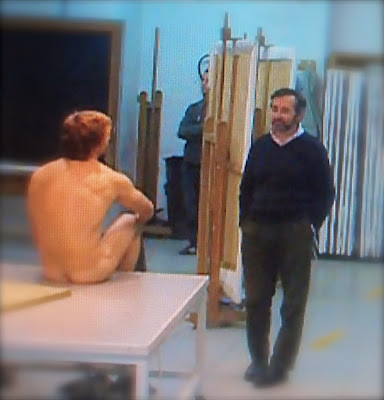
martes, 29 de noviembre de 2011
sábado, 26 de noviembre de 2011
martes, 22 de noviembre de 2011
RETABLITO PARA MUERTOS. (Oil and tears on canvas)
 El barroco es la prueba definitiva de la contradicción humana. Teóricamente es la negación del mundo: no es cosmos, sino caos. Es la negación de la vida, inconsistente y fatigosa y, en definitiva, la paciente espera de la muerte.
El barroco es la prueba definitiva de la contradicción humana. Teóricamente es la negación del mundo: no es cosmos, sino caos. Es la negación de la vida, inconsistente y fatigosa y, en definitiva, la paciente espera de la muerte.Crls
Baroque is the ultimate test of human contradiction. Theoretically it is the negation of the world, is not cosmos but chaos. Is the negation of the inconsistent and laborious life and, ultimately, the patient waiting for death.
domingo, 20 de noviembre de 2011
BARROCO (Quién da más?)






En el siglo XVIII, por primera vez, de forma rotunda, el arte se mostraba como un instrumento de propaganda decisivo, y el barroco, por efectista, era el estilo más adecuado para ello, ya fuera en pintura, en escultura o en arquitectura. Por si fuera poco, el barroco era un estilo idóneo para conjugarse con toda clase de culturas indígenas y su hibridación con ellas logró un éxito tal que tomó un vuelo propio principalmente en toda Latinoamérica, con ricas variantes locales, que se prolongaron, sin pérdida de vitalidad, hasta bien entrado el siglo XIX.
Como ocurriera ya en su día, cunado las vanguardias del siglo XX, en cuyo seno la presencia española fue decisiva, promovieron la recuperación del estilo barroco como antecedente del arte transgresor y revolucionario, de nuevo vuelve a captar el interés de los más avispados comisarios. Si España había sido considerada como "un capítulo aparte" de la cultura occidental moderna, entre otras cosas por su orientación anticlásica y antihumanista, ahora esta diferencia es motivo de creciente y estimulante interés. En un mundo en el que se tambalean los valores institucionales y los referentes clásicos, el Barroco hispano resurge de entre las cenizas como elemento de renovadora pasión.
(D. Jordá. De Verdad Digital. "Barroco español para un mundo en crísis")
In the eighteenth century, for the first time, bluntly, the art was displayed as adecisive instrument of propaganda, and the Baroque, was indeed the most appropriate style for it, whether in painting, sculpture or architecture. What's more, the Baroque was a style suited to combine with all kinds of indigenous cultures and their hybridization with them achieved a success that flew mainly in Latin America itself, with rich local variants, which lasted, without loss of vitality well into the nineteenth century.
As it happened already in his day, brother twentieth century avant-garde, within which the Spanish presence was decisive, promoted the recovery of the Baroque style as an antecedent of transgressive and revolutionary art, again returns tocapture the interest of the most astute curators. If Spain had been regarded as "a separate chapter" of modern Western culture, among other things, anti-classicaland anti-humanist orientation, now this difference is a growing and excitinginterest. In a world in which institutional values are staggering and classic references, the Spanish Baroque rises from the ashes as part of renewed passion
As it happened already in his day, brother twentieth century avant-garde, within which the Spanish presence was decisive, promoted the recovery of the Baroque style as an antecedent of transgressive and revolutionary art, again returns tocapture the interest of the most astute curators. If Spain had been regarded as "a separate chapter" of modern Western culture, among other things, anti-classicaland anti-humanist orientation, now this difference is a growing and excitinginterest. In a world in which institutional values are staggering and classic references, the Spanish Baroque rises from the ashes as part of renewed passion
viernes, 18 de noviembre de 2011
miércoles, 16 de noviembre de 2011
martes, 15 de noviembre de 2011
lunes, 14 de noviembre de 2011
domingo, 13 de noviembre de 2011
jueves, 10 de noviembre de 2011
martes, 8 de noviembre de 2011
sábado, 5 de noviembre de 2011
jueves, 3 de noviembre de 2011
miércoles, 2 de noviembre de 2011
martes, 1 de noviembre de 2011
Suscribirse a:
Entradas (Atom)
























